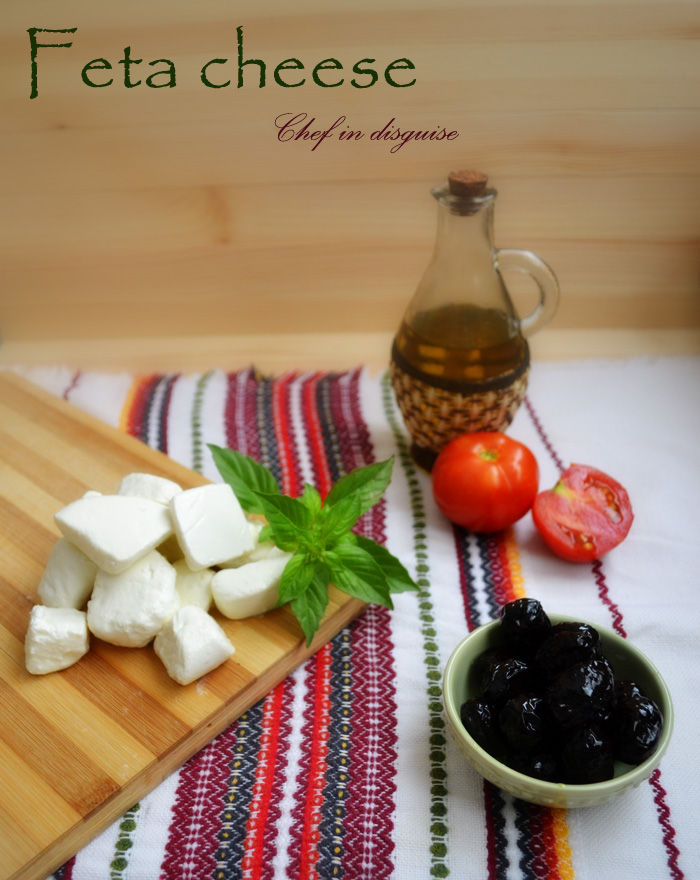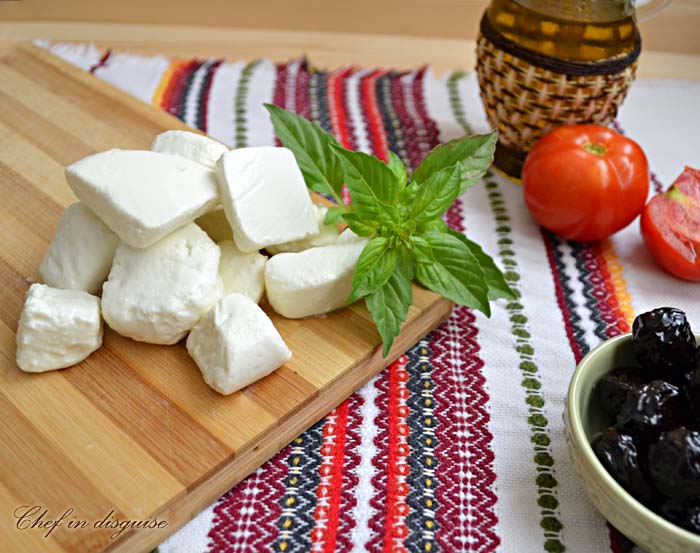Feta cheese is a type of Greek cheese that is pickled or brined. The brining process gives feta cheese its characteristic salty, tangy flavor and a crumbly consistency.
Feta cheese can be served as a table cheese, used in baking savory dishes usually paired with spinach as a filling for pastry or as a stuffing for chicken, or served as an appetizer or in salads( it is a key ingredient in Greek salad which I will be sharing soon).
I have always bought my Feta cheese until John of From the Bartolini Kitchens posted his recipe for Feta cheese. If you are not familiar with John’s post you are really missing out. John shares authentic Italian recipes that his mother and Zia prepared, each recipe comes with a heart warming story, is beautifully written and his attention to details ensures that you will get the recipe right the first time for sure.
I have made ricotta cheese, homemade yogurt, labneh, Nabulsi cheese and cottage cheese (coming soon) and thought I was ready to take on a new cheese and I am really glad I did. This home made Feta tastes so much better than anything you can buy, its consistency, depth of flavor only get better with time and you can store it in the brine solution in the fridge for months.
Home made Feta cheese
Recipe Source: From the Bartolini kitchens
Ingredients
yield: approx ½ pound
½ gal (64 oz or 2 liters) goat’s milk (cow or sheep’s milk may be used) – ultra-pasteurized goat’s milk cannot be used.
1 tablespoon live culture, plain yogurt mixed in 1 tbsp milk from above (I used homemade yogurt)
¼ rennet tablet dissolved in 3 oz distilled water at room temp
1/2 teaspoon salt
To make the brining solution
5 1/2 tablespoons of salt for every 20 oz fluid whey
Directions
Warm the milk in a pot with a lid to 30 C or 86 F making sure you stir it occasionally to prevent the bottom from burning
Remove from heat, add yogurt-milk mixture, stir well, cover with the lid, and let sit for 1 hour at room temperature.
Move pot to an area where it will remain undisturbed, add dissolved rennet, stir quickly to ensure even distribution of the rennet then cover the pot, and leave overnight.
The next morning,the cheese should be set into one large block of curd with a little whey separated on the side
Now you have to check for a clean break.
To check for a clean break Stick your finger, on an angle, into the curd and slowly bring the finger to the surface to test for a “clean break,” meaning the curd is firmly set from top to bottom. Your finger should come up relatively clean which means that the cheese has set into one block of curd.
A bad break is when your finger comes out covered in a thickened dairy product, that means that your cheese has not set completely, if that happens you need to leave it for 2 hours and check again. If you still get a bad break give it 2 more hours and check again. If you still get a bad break you have to throw it out and start over
Now that you have achieved a clean break you have to cut the cheese and this step is done to allow as much whey to separate from the cheese as possible
Using a long knief cut parallel lines through the entire thickness of the curd dividing it into vertical slices
Then turn the pot and cut horizontal parallel lines throught the entire thickness of the curd  Next take your knife at an angle and repeat cutting horizontal and vertical lines to cut the curds that are beneath the surface, stir the curds gently and cut any cubes that are too big
Next take your knife at an angle and repeat cutting horizontal and vertical lines to cut the curds that are beneath the surface, stir the curds gently and cut any cubes that are too big
Allow the curd cubes to set for 15 minutes stirring it occasionally to allow more whey to come out. You will notice that the curds will shrink slightly in size.
Now it is time to strain the cheese, to do that line a colander with a cheesecloth or a clean fabric with fine weave.
Gently pour the curds and whey in and allow it to strain. Do not discard the whey.
Once most of the whey has been strained collect the 4 corners of your cheesecloth and tie them to form a knot that allows you to suspend the cheesecloth then allow it to strain for 2-4 hours.
If you live in a very warm place you may want to allow it to strain in the fridge.
The next day remove the cheese from the cloth,break up the curds add 1/2 teaspoon salt.
Line a mold with holes in the bottom with cheese cloth, place the cheese in, fold over the cheesecloth place a heavey weight on top of the mold and leave overnight, again if you live in a really warm place do this in the fridge

Make the brine solution by adding 5½ tablespoons of salt for every 20 fluid ounces of whey and mix it, dissolving as much of the salt as you can.
The next day take the cheese out of the mold and cut into cubes, place in the brine solution and allow to brine in the fridge for 5 days
Store in the refrigerator. Rinse before use to remove excess salt.
NOTES:
The milk: you cannot use ultra-pasteurized milk, alone, to make feta.Your best choice is raw, unpasteurized milk, sheep would be the tastiest.The second best choice is regular pasteurized cow or goat milk. If the only choice you have is ultra-pasteurized cow’s milk, you must add CaCl2 to mask the effects of the ultra-pasteurization process. CaCl2, however will not work with ultra-pasteurized goat’s milk.
What to make with feta cheese?
How about a Greek salad? (recipe coming soon)
or this feta mint tomato salad or salsa?(recipe coming soon)



























